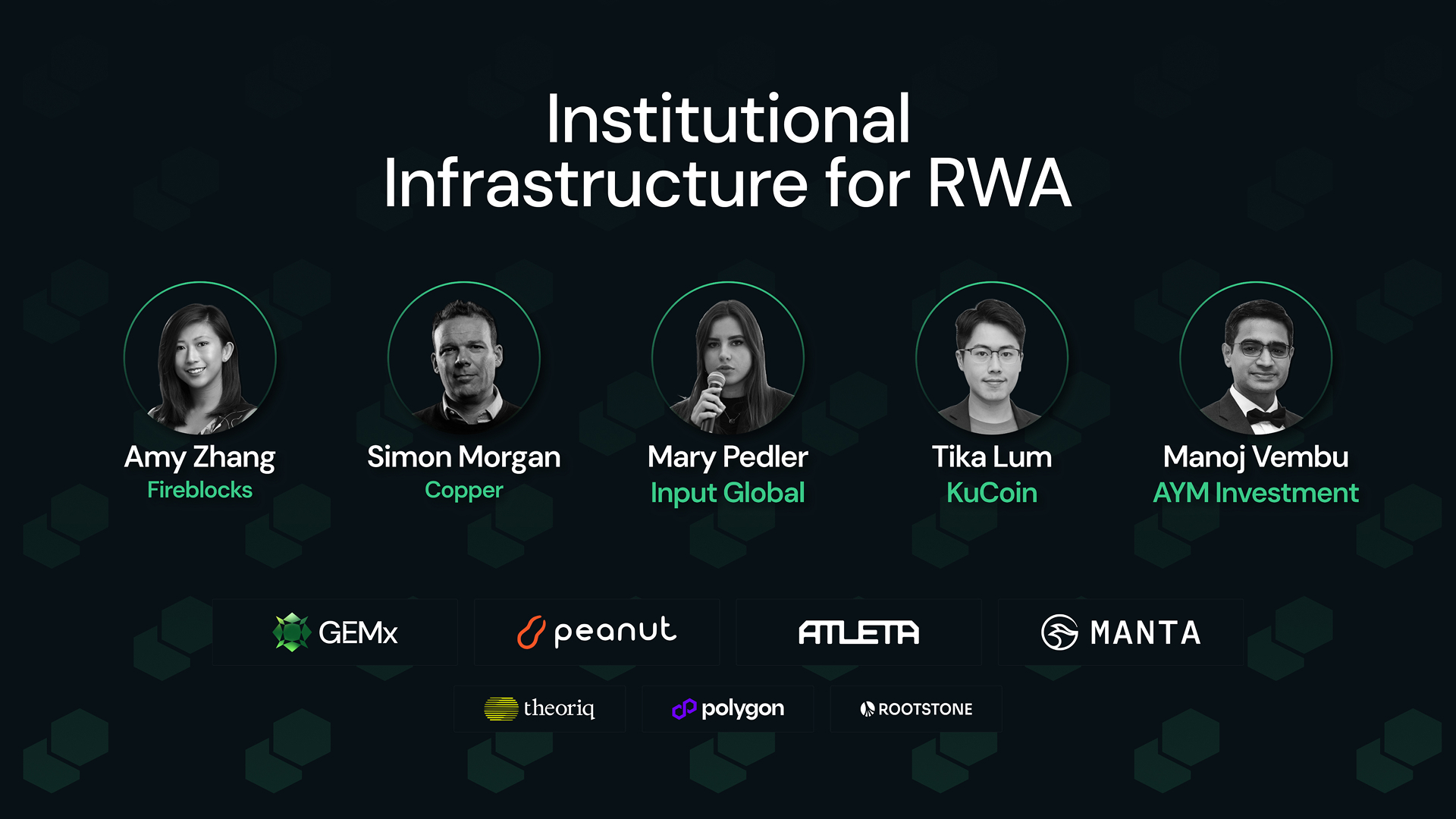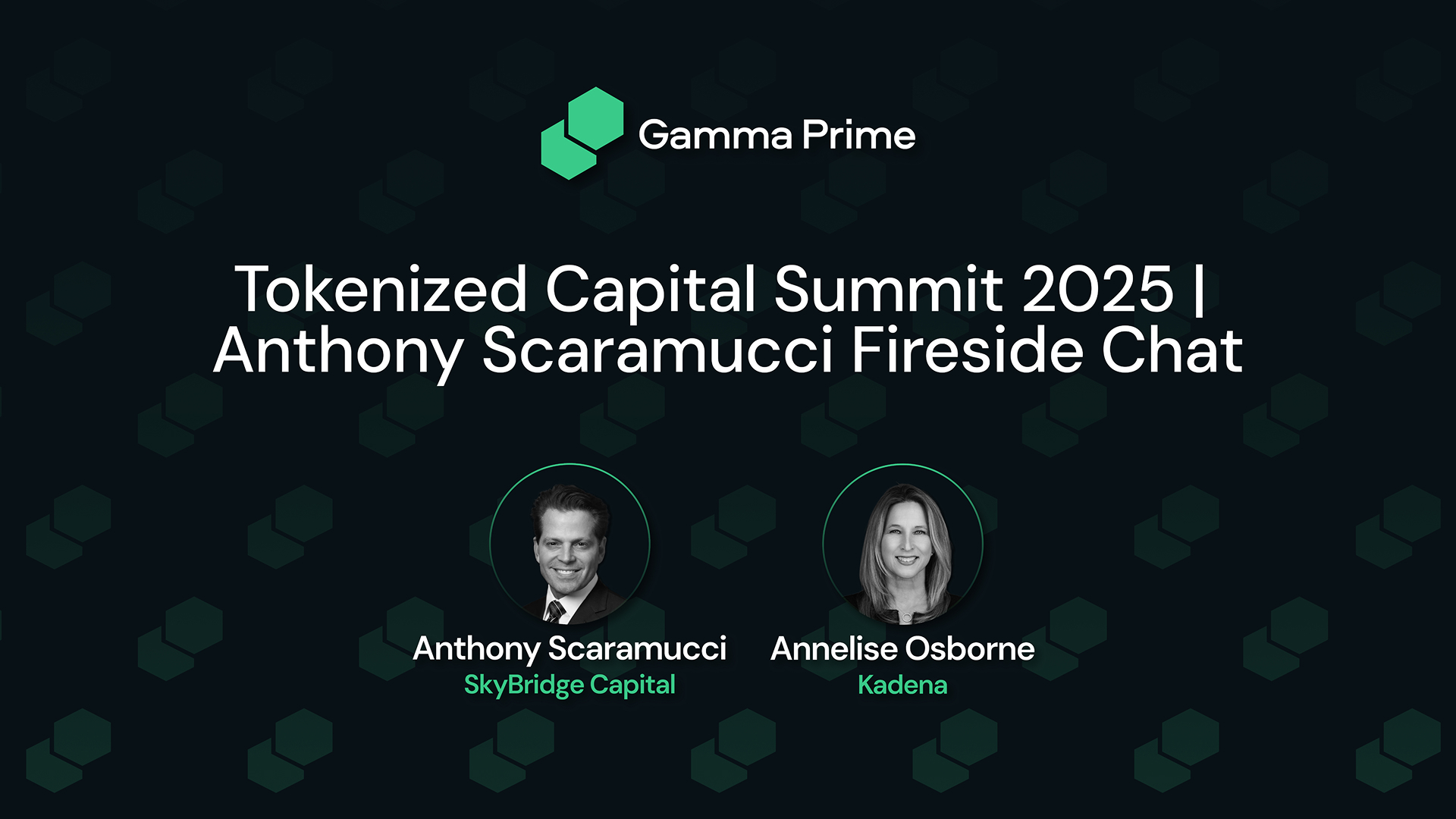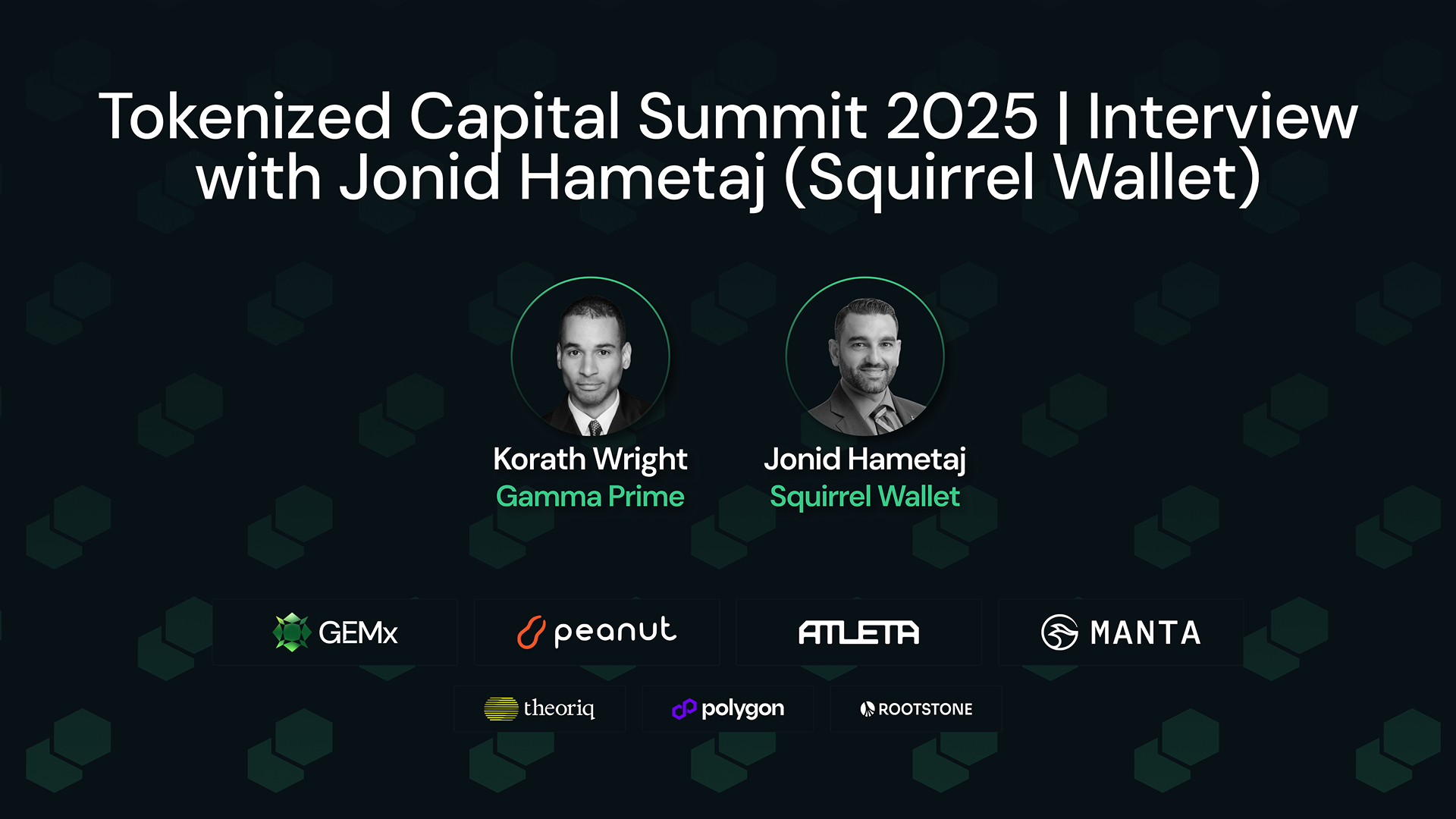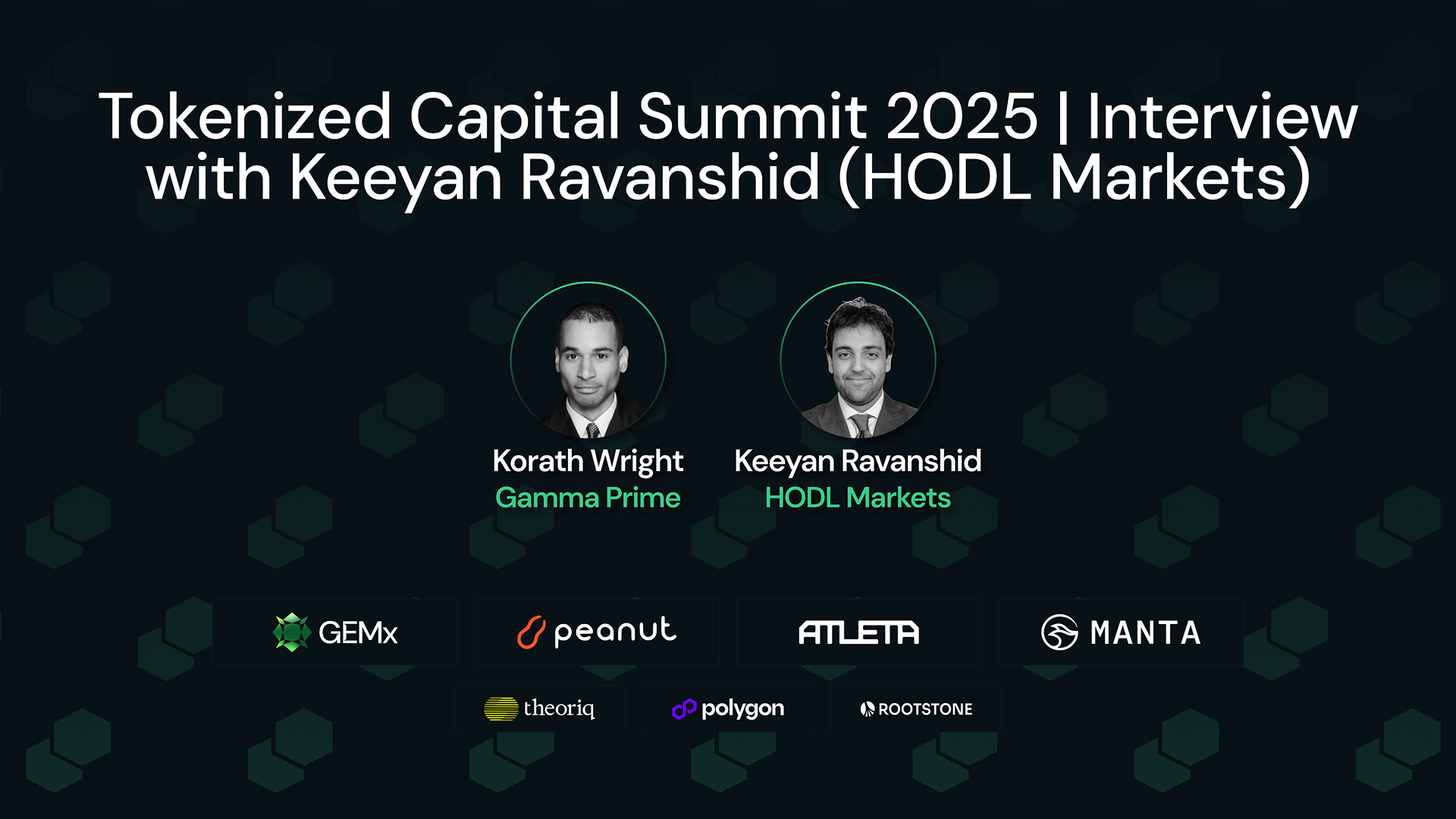Watch the video of this panel discussion on Gamma Prime’s YouTube channel:
Panel discussion with Mary Pedler (Founder of Input Global), Amy Zhang (Head of APAC at Fireblocks), Simon Morgan (CEO at Copper Securities), Tika Lum (Head of Global BD at KuCoin), and Manoj Vembu (Co-Founder and Director at TRST01).
This panel explores how traditional financial institutions are adopting tokenization and blockchain technology to bring real-world assets (RWAs) — such as money market funds, real estate, and commodities — on-chain. The discussion focuses on infrastructure challenges, institutional vs. retail adoption, risk management, and the future of tokenized assets over the next decade.
Mary Pedler (Input Global):
Hello everyone, my name is Mary Pedler, and I will be a moderator of the opening panel today. I am the founder of Input Global, we are a web3 marketing communications agency. We are working across the markets and helping such brands as Bitget, Tron, Tether, Samsung to get visibility. I would like to ask our speakers to do a short introduction of themselves — what are you doing, your position, the company that you represent, and of course, what excites you most about tokenization.
Amy Zhang (Fireblocks):
Good morning, everyone. My name is Amy, I lead the APAC business for Fireblocks. Fireblocks provides a secure digital asset infrastructure from your two men in a garage trading crypto all the way to some of the largest financial institutions in the world. A fun fact: we are now processing on average anywhere between 10–15% of all the on-chain transactions for major chains. From our perspective, the tokenization future is an on-chain future, and we are very excited to support that growth.
Simon Morgan (Copper):
Morning everybody, Simon Morgan, I am the Chief Revenue Officer for Copper. Copper was born as a digital asset custodian. Increasingly we are better known as a collateral management business. Our largest product, Clearloop, enables institutions to post various types of collateral to exchanges to trade in a safe, secure way. As more assets become tokenized, that becomes very interesting for us, enabling institutions to use blockchain-based assets as collateral. That’s really our big focus around the tokenization space.
Tika Lum (KuCoin):
Hi everyone, this is Tika Lum from KuCoin. I am the Director and Head of Global Institutional Sales at KuCoin, leading the Institutional Sales team, covering more than 200 countries and serving 41 million users all over the globe. We provide best-in-class trading solutions, including off-chain solutions, loan products, as well as API infrastructure to hedge funds, market makers, brokers, institutions, and VIP clients.
Manoj Vembu (AIM Investments):
Hi everyone, welcome to Singapore, whoever is coming for the summit from outside. My name is Manoj Vembu, I am an entrepreneur, investor, and technology enthusiast. I have invested in a few Layer 1s and L2s in the past, out of my curiosity to learn more about blockchain. Today I represent one of my investing companies called AIM Investments. It’s more like a SPAC for RWAs. We are launching our first SPAC-themed investment operating asset based out of Asia, investing in precious metal mines and bringing that as a productive asset. We are keen to know how traditional assets can be revolutionized using tokenization. That’s the main reason we are launching this first concept of SPAC for RWAs.
Mary:
So you all have chosen the institutional-first approach. But if we compare two different markets — retail and institutions in RWA — what is the highest demand for institutions coming from, and what are the main use cases that you see according to your experience? And if you can compare it to retail, that would be great as well.
Amy:
Right now the story with RWAs is really around tokenized money market funds and, as a by-product, the excitement people are seeing through stablecoins. On that front, cross-border payment use cases, particularly for B2B payments, are getting very exciting. For instance, in Singapore, you already have Alipay settling with Grab using stablecoins for B2B flows. That also adds liquidity to the stablecoin industry.
On the real-world asset front, corporates, banks, and payment service companies want better treasury management. On-chain mechanisms allow stablecoins to be used for payments and then instantly swapped into treasury plays. This instantaneous on/off-ramp for institutions is an exciting way for companies to manage treasury and get access to yield, which historically has been captured by financial institutions and banks.
On the retail side, retail are not looking at stables to money market fund plays for yield. Retail mostly look at stables to DeFi or Web3 yield enhancement mechanisms. That’s where many are getting yield at the moment.
Simon:
I agree with Amy, but in a slightly different way. The invention of tokenized money market funds over the last 12–18 months is the first step. We’re seeing increasing amounts of clients, particularly from the traditional space, who want to use those as collateral to trade on various exchanges and other venues in the crypto landscape.
There are two reasons. First, the access to yield is important, even though stablecoins reward similar amounts. Second, some funds still cannot hold crypto. The ability to hold a traditional security is hugely advantageous.
What I find extraordinary is how fast this space is moving. The SEC is making statements that they believe all assets will be tokenized and on-chain. From where we stand, we welcome as many assets as possible to be blockchain-based, so institutional clients can use them as collateral. This hopefully goes far beyond just crypto, which is where it gets really exciting.
Tika:
I agree with Amy and Simon. When talking about RWAs, tokenized money market funds have a similar yield-generating nature as synthetic dollars like stablecoins. But institutions prefer tokenized money market funds because of compliance and regulatory clarity. They are issued by giants like BlackRock, Fidelity, and UBS Asset Management.
To cope with this, KuCoin launched an RWA collateral mirroring solution (RCMS). We accept tokenized money market funds as trading collateral while institutions avoid direct exposure to crypto or stablecoins. At the same time, they enjoy yields and can trade on KuCoin.
Retail doesn’t really care about this. They look more into synthetic dollars with 2–3% yield. Institutions focus on security, safety, and compliance.
Manoj:
I fully agree with the panelists, but let me give my perspective. I come from a traditional business view. Global commerce today is about $6 trillion, powered by real-world assets not yet in crypto. About 1% of this is just starting to step into crypto — real estate tokenization and others, mostly revolving around money markets.
Institutions are driving it today, but I think this will change. Retail participation will grow versus institutions. SEC comments that every asset will be tokenized, and inter-country panels are exploring RWA tokenization bridges. These are starting points where a large portion of that $6 trillion will flow into RWAs and tokenization, faster than expected.
Five years ago, nobody thought stablecoins would be so mainstream. Today, with RWAs, people might not realize what will happen in five years. I believe a large portion of real-world assets, not just money market funds or institutional drives, but retail-driven assets, will take over.
Mary:
And if we’re talking about the progress of this industry, what do you think is the main challenge? Like, what could be the barrier for institutions to come and explore RWA?
Amy:
I think there’s maybe a lack of willingness on their end, and the reason why I say that is because fundamentally, RWA is a technology that could—well, blockchain is a technology that can help to reduce a lot of the middleman risk and provide better liquidity, transparency, all these nuances. And as folks in the panel and probably in the audience who have ever tried to convince anybody to use new technology, it’s just a very painful process because people are really resistant to change for many, many different reasons. So I think there’s this innate, I would say, unwillingness in the traditional market to adopt new technology in general, which underlines the current, but doesn’t mean they will not, right?
If you think about the transition of how industries have gone on in terms of the cloud space, eventually over the next 20 years, they’ll all adopt in some shapes or form. So I think that’s one challenge that we all just in the industry have to be aware of. On the flip side of that, I think there are just specific problems that people get to resolve.
For instance, the challenge around liquidity, the fact that we’re building our WA market and also tokenized industries, and we’re recreating all of the rails, and recreating all of the liquidity venues, and recreating all where people are putting money in and out, that is a challenge, right? So I think that a lot of folks now are looking, finding ways to bridge the TriFi liquidity with the crypto ecosystem, and we’re seeing a lot of crypto firms launching tokenized projects and really TriFi firms launching tokenized crypto projects and finding that blend so we don’t have to reinvent the liquidity.
And on the back end, which is kind of the world that Firebox lives in, we’re really just about reestablishing that rails to allow that integration to be done in a very seamless way, either through Firebox customer-to-customer viral network or connectivity to various different exchanges and venues to help them get that liquidity easier so that technology, in terms of adoption, isn’t really a hurdle for them to move forward. Another nuance I think a lot of people think about is the operational flows for real world assets in the traditional sense is really complicated and super cumbersome, and in the crypto world, we’re used to things being done instantaneously, 24-7, very well controlled, and trying to retrofit this super fast running engine into the traditional way of operating is just something we’re trying to address now.
Manoj:
Let me add this. I’ve always thought about institutional capability of deploying capital very much equivalent to just their understanding of the risk. It’s all about risk.
Because institutions are not individuals, they can’t take a quick decision on a snap of the fingers, but they have to go through a process. So we see a lot of traceability, transparency, visibility, and risk awareness before an institution takes a step towards deploying their capital. Versus what happens in the retail market.
Retail, you and me can take a decision on a snap of the fingers, and then understand, go by our guts, and then put our money behind anything that’s looking more attractive and more plausible to our mind. So from that angle, I think institutionals will remain as more risk averse. They will not be jumping onto everything and anything that they are looking at from the RWA space, but that will also determine how well they can depute capital on some of the new areas.
So for example, when we launched AIM Investments early this year, we were going through a number of paperwork. Though we are looking at tokenization and it was seemingly pretty easy for us to get started, it was not. We had to go through the entire process of KYC just to open a small little bank account. It’s so crazy that the paperwork just destroys your time and effort that you put in for looking at the tokenization aspects. So from that angle, I think institutionals will always remain most risk averse, but individuals, retails, is going to propel the next wave of RWAs.
Mary:
Okay, Simon, what is your perspective on this?
Simon:
Look, I agree with Amy. I mean, infrastructure is everything. Both copper and fireblocks are both at the forefront of that, providing sort of blockchain rails to enable these assets to move around.
I mean, I wouldn’t say it’s a controversial view, but in terms of the way we view the world and I think about these assets being used as collateral, I think the world is a bit smaller than perhaps we think. You know, tokenized money market funds is the perfect place to start. That’s an obvious thing that clients, institutional clients, will use to pledge as collateral in various ways.
And I’m thinking away from the crypto ecosystem here. You think about any OTC derivatives trade, today you would pledge T-bills, cash, you know, being able to pledge a tokenized money market fund is an obvious thing to replace that with because it’s easier to move around the system in terms of collateral. So I think that space expands out a little bit institutionally and you end up having tokenized gold products or whatever high quality liquid asset you want to choose in a tokenized form that is more useful.
Do I believe institutionally that things like tokenized real estate and things like that have an enormous amount of value at this point? I personally don’t. I think they are more a retail based product, which I can see a lot of advantages to.
I mean, I live in Abu Dhabi where they’re trying to tokenize every single building in the world. And there is an element of I look at that and think, yeah, I wouldn’t mind owning a piece of that building. But as an institutional product, I don’t see the value in that.
So we are very focused on RWAs, tokenized, whatever it might be in a collateral use case. And I think that’s where this really gets interesting quite quickly.
Tika:
Yeah, I totally agree with Simon on this because RWA is not really a new concept, to be honest, it’s there for more than five, six years already. But why nowadays we are talking about RWA that much, why is it becoming viral nowadays?
So we are talking about RWA of real estate, wines, energy storage. But this kind of assets from the traditional finance world, they are already there. And for a lot of retail investors, they do not really understand it. But for institution wise, we are talking about tokenized liquid financial products.
This is the way that this is the only thing that I think I totally agree with Simon. This is the only way out of RWA because RWA ultimately is just a solution, it’s a technology. It should be solving some problem that the users are facing.
So for the institutional use case, RWA as a tokenized money market or tokenized liquid financial products as a collateral is solving two major problems. One is about on-ramping and off-ramping. So the second thing will be like additional yield generation.
We are talking about like now, nowadays we are talking about those tokenized money market fund. It’s not just about real world assets, it’s a real world applications that we finally have a real use case here for institutions.
Mary:
Okay, and first one, so in the perspective of 10 years, what will be the main three tokenized assets?
Manoj:
Real estate, infrastructure, energy.
Simon:
I’ve got no idea. If you listen to Paul Atkins, it’s everything. But I mean, again, I would say from my perspective, it’ll be any high quality liquid asset will be tokenized and will be used frequently.
Tika:
You can tokenize anything, right? Actually, you can tokenize a chair or table even though, right? But the main point, just back to what I mentioned, is the use case. So why you want to tokenize that thing?
From an institutional perspective, I totally agree with Simon. All the liquid financial products, T-bills, we have money market funds and next step. We’re already seeing tokenized equities already. So those liquid products, they will be, only this kind of process will be the mainstream from the institutional level.
But for let’s say real estate, other illiquid products, I would say I agree with, I agree as well. So retail, retail would really like to have fractional like assets of these kinds of products. So in that sense, RWA is helping.
Amy:
So I think the area that is going to be tokenized the most is, it’s likely that in the next 10 years, every country is going to have their own stable quiz of some sort. And subsequently, the treasury will be managed that currency’s money market fund. Those two categories can continue to perpetuate in a really meaningful way, because right now that store is fully dominated by the U.S. and the U.S. denominated assets. So that’s your one and two.
And the third thing I actually think the whole liquid asset conversation around if they should be tokenized or not, to be honest, at the end of the day, tokenization is a technology and some liquid assets got really tech infrastructure already. Some of them are really resistant to change.
You compare like equity versus bond, the equities trading systems are pretty good, right? And by the way, like when the U.S. started going from T plus one to T plus zero settlement for stock trading, the rest of the world really panicked because the reality is the world does not operate 24 seven, seven days a week.
I actually think the more likely things to be tokenized as third is not to transition traditional asset to be tokenized liquid or not, but rather like newer assets that currently don’t exist today that could be leveraged using this new technology on new infrastructure.
Really like the rage and the craze these days is really about carbon credits, like things that are trading at the moment that is net new relatively doesn’t have a lot of legacy infrastructure debt and probably the next 10 years can’t see that change from happening and it just adopted much quicker than let’s say traditional rail has been going around for hundreds of years.
Mary:
That’s really interesting. So let’s see. Let’s see. And I think it’s time to wrap it up. Do we have questions from the audience?
Chaman Malhi (Gamma Prime):
Not this time, but I do want to encourage you to ask the questions if you happen to catch the speakers throughout the event. And I also want to ask you to give our first round of the speakers the biggest round of applause you have ever given. So let’s give them a hand.
Mary:
Thank you so much.



